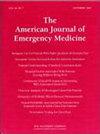小剂量氯胺酮治疗急性疼痛:叙述性综述
IF 2.7
3区 医学
Q1 EMERGENCY MEDICINE
引用次数: 0
摘要
引言 急性疼痛治疗是院前和紧急医疗护理的重要组成部分。然而,阿片类药物的风险和副作用促使医疗服务提供者使用低剂量氯胺酮(LDK)来安全有效地治疗急性疼痛。院前回顾包括评估 LDK 在民用和军用环境中使用情况的研究。我们利用 PubMed 查找了与该主题相关的前瞻性和回顾性临床研究。我们将纳入的研究限定为 2024 年 1 月 30 日之前用英语发表的高质量前瞻性和回顾性临床和观察性研究。我们没有根据患者人群或给药方式来限制研究的纳入范围。我们采用了 PRISMA-ScR 核对表来进行此次综述。结果根据我们的方法,我们发现有 249 篇出版物符合我们的检索策略。根据摘要审查,其中 178 篇出版物明显不符合纳入标准。我们对 71 项研究进行了检索和更详细的审查。其中,22 条记录在审查后被排除,43 条符合最初的纳入标准。通过 "滚雪球 "的方式又找到了 22 项研究。总共有 64 项研究符合本分析的纳入标准。21 项研究涉及院前环境中急性疼痛的治疗,其中 4 项为随机临床试验 (RCT)。43 项研究评估了急诊室急性疼痛的治疗。其中包括 28 项随机临床试验。综合来看,这些研究表明,单独使用 LDK 并不优于阿片类药物。当作为阿片类药物治疗的辅助用药时,氯胺酮可以起到节省阿片类药物的作用。结论LDK是一种安全有效的急性疼痛治疗方法。LDK可作为阿片类药物的替代疗法,也可与阿片类药物联合使用,通过其阿片类药物稀释效应减少阿片类药物暴露。重要的是,LDK 有多种剂型,包括肌肉注射、静脉注射和鼻内注射,因此在院前和急诊室环境中都是一种有效的急性疼痛治疗选择。在不断发展的急性疼痛治疗领域,LDK有望成为一种紧急治疗药物。本文章由计算机程序翻译,如有差异,请以英文原文为准。
Low-dose ketamine for acute pain: A narrative review
Introduction
Acute pain management is a critical component of prehospital and emergency medical care. Opioids are effective; however, the risks and side-effects of opioids have led providers to use low-dose ketamine (LDK) for safe and effective treatment of acute pain.
Methods
We conducted a scoping narrative review to explore the efficacy of LDK for the treatment of acute pain in the prehospital setting and emergency department (ED) setting. The prehospital review includes studies evaluating the use of LDK in both civilian and military settings. We utilized PubMed to identify prospective and retrospective clinical studies related to this topic. We limited study inclusion to quality prospective and retrospective clinical and observational studies published in the English language prior to January 30, 2024. We did not limit study inclusion based on patient population or mode of administration. We utilized the PRISMA-ScR checklist to conduct this review.
Results
Using our methodology, we found 249 publications responsive to our search strategy. Of these, 178 publications were clearly outside inclusion criteria based on abstract review. Seventy-one studies were sought for retrieval and more detailed review. Of these, 22 records were excluded after review and 43 met initial inclusion criteria. An additional 22 studies were found via snowballing. In total, 64 studies met inclusion criteria for this analysis. 21 studies related to the treatment of acute pain in the prehospital setting, four of which were randomized clinical trials (RCTs). Forty-three studies evaluate the treatment of acute pain in the ED. This included 28 RCTs. Taken together, the studies suggest that LDK is non-inferior to opioids when used alone. When used as an adjunct to opioid therapy, LDK can provide an opioid-sparing effect. Ketamine doses <0.5 mg/kg were not associated with significant side effects.
Conclusions
LDK is a safe and effective option for acute pain treatment. It can be used as an alternative therapy to opioids or used in conjunction with them to reduce opioid exposure through its opioid-sparing effect. Importantly, LDK is available in a variety of formulations including intramuscular, intravenous, and intranasal, making it an effective acute pain treatment option in both the prehospital and ED settings. LDK holds promise as an emergency treatment in the evolving landscape of acute pain management.
求助全文
通过发布文献求助,成功后即可免费获取论文全文。
去求助
来源期刊
CiteScore
6.00
自引率
5.60%
发文量
730
审稿时长
42 days
期刊介绍:
A distinctive blend of practicality and scholarliness makes the American Journal of Emergency Medicine a key source for information on emergency medical care. Covering all activities concerned with emergency medicine, it is the journal to turn to for information to help increase the ability to understand, recognize and treat emergency conditions. Issues contain clinical articles, case reports, review articles, editorials, international notes, book reviews and more.

 求助内容:
求助内容: 应助结果提醒方式:
应助结果提醒方式:


